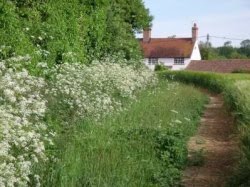




Tomatoes are the only vegetable it is safe to bottle (or "can") without the use of a pressure canner; this is because they are quite an acidic vegetable (or fruit if you like), and it's the acidity that guards against botulism in the processed produce. I've been at this for over 20 years, so thought I'd share my method, and in response to a request from Shropshire Girl.
Gather together what you will need: tomatoes, water, salt, lemons, clean jars with lids, seals, etc.
Set a big pan of hot water on the stove to simmer just under boiling; place a folded tea towel or thick dishcloth in the bottom for the glass jars to stand on so they don't get too close to the heat source which may crack the jars.
I bottled 2 x 1 pint jars this morning, so made up approx 1 pint of brine - 1 pint of cold water with 1 oz of table salt dissolved in it. To this, I added the juice of half a big lemon. Stir well to dissolve the salt, and set aside. The amount of brine needed is variable, according to size of fruit etc being bottled, but is quick and easy to make up if more is required. Sort over the tomatoes, removing any blemished or overly soft ones; take off any stalks. Small ones can be left whole, or halved as liked; bigger ones can be halved or quartered. Make sure they are clean, wiping over if necessary, and pack into the jars without pressing them down too much - the aim is to get the tomatoes to keep as much of their shape as possible. Pour over the brine, so that it just covers the top tomatoes. Put on lids and seals according to type of jar. If using screw tops, don't screw too tight, but don't leave them loose either; just tightened is about right.
Place jars in pan of water, on the cloth, get the water to just on the shoulder of the jars, bring to just a bubbling simmer, then on with the lid and process for 40 minutes. After this time, remove from the pan carefully and place on a wooden board to cool. When cool, test for a seal by removing the ring or clip, and checking that a vacuum has formed - the sealing ring and the lid should be fast together. Replace ring or clip, wipe over jars, label and store in a cool, dry, dark place until needed. If there is a problem and the seal isn't made, just put this jar in the fridge and use it up sooner. Use the hot water from the pan for washing up :)
Bottling is the way to go - easy, safe, cheap (once the initial investment in jars and rings etc is made, which will last for eyars if care is taken), and no energy used in the storage. The flavour of fruit particulalry is much superior to frozen fruit, which I have almost stopped doing now, in favour of the bottled fruit. A big bonus is that you don't have to remember to defrost it either! Invest in the proper jars; not all those made for storage, even though they have rubber rings, are suitable for processing in heat, with thin glass that will probably shatter. secondhand ones are stillf airlye asy to come by. Two names I trust are Kilner and Le Parfait.
Bottling is a great string to add to your bow, and you won't be left with piles of rotting food when the lgihts go out and the freezers go off.
Further discussion here on my forum:
http://creativeliving.10.forumer.com/viewtopic.php?t=437If you have any further questions, just shout and I'll try and help.























